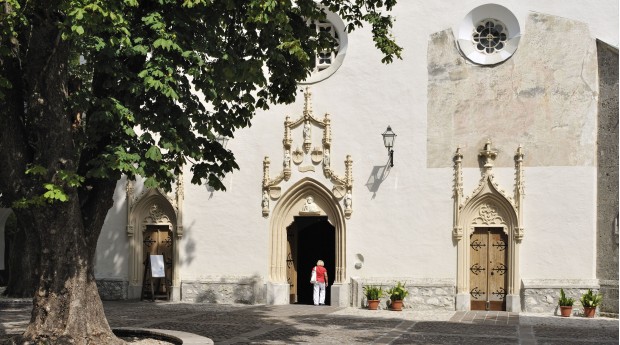St. Peter's Church
An exceptional example of the gothic three-nave churches. It is adorned by beautifully designed vaults, an angel star and a black marble altar.
The simple exterior appearance of the church dates from the end of the 19th century, when, due to stylish conformity, the church was restored to its original gothic form. The facade, the stain-glass windows, the entrance portal and its embellishents were renovated.
The interior of the church
On entering the church you step into a hall, which is divided into three by pillars that support the ribbed vault, made up of an eight-point star. The vault of the central nave is embellished with an angel star. The presbytery also has a high star-shaped vault with figurines.
In the 18th century the original main Gothic altar of St. Peter was replaced by a black marble altar, the work of Ludovic Bombassi from Ljubljana. The statues of St. Leopold and St. Nicholas at the side are the work of Angelo Pozzo. In the presbytery there is a newer altar, oriented towards the congregation, the work of the sculptor Janez Jarm.
At the end of the southern nave is a shrine to Mary. The white Mary's altar is the work of Janez Vurnik Jr. from 1898. At the end of the northern nave is a tabernacle, which was designed by the local architect Ivan Vurnik in the 1930s, and was painted by his wife Helena Vurnik. On the side altars of Saints Roch and Sebastian, as well as St. Catherine, there is preserved paintings from 17th century altars.
The surroundings
In the 14th century the church and rectory was surrounded by a wall. Behind the church in a bunker from World War II there is a shrine to Edith Stein. In the rectory courtyards there is a preserved area where there was once a tavern. The shrine and tavern can be viewed by prior arrangement or as part of a guided tour of Radovljica.
The origins of the church
It is likely that as far back as the 10th century a proprietary chapel stood on the site of today's church, which, at that time, was the only building on the promontory. With expansion of the town and its increasing wealth the church also grew. By the 13th century it had already become so well established that the seat of the archdiocese was moved from Rodine to Radovljica. Around the year 1500 a gothic church was formed from the three-nave romanesque basilica. The year 1495 shown above the door may indicate the beginning of the great renovation.
Related news
The heart and soul of Radovljica is Linhart Square which inspires with the variety and authenticity of its preserved architecture.
In front of Radovljica's church stands a bronze statue of Cene Avguštin. Behind the statue is an exhibition, based on his work, that details the development of the town.
Explore one of Slovenia's most beautiful town centres in the company of a local guide.
Every Tuesday morning Radovljica's Tourist Information Centre invites you to join a guided tour of the old town centre.





